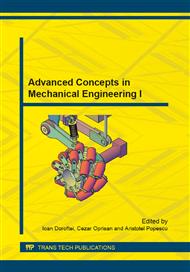p.489
p.495
p.501
p.507
p.513
p.520
p.526
p.535
p.541
Experimental Validation of a Finite Element Model of an Osteoporotic Human Femoral Bone Using Strain Gauge Measurement
Abstract:
The complications of fractures caused by osteoporosis have a mortality rate of 15-20 % in elderly people, leading to severe physical disability and long term home care [1]. Although currently, the technology that allows us to prevent osteoporosis and fractures caused by this disease exists, the statistics are concerning and can be considered basis for further research regarding this pathology of the bone tissue. This paper aims to address this issue form an engineering perspective by achieving experimental validation of a finite element model of an osteoporotic human femoral bone using strain gauge measurement for an in vitro analysis. A Computer Aided Design (CAD) model based on a CT of a human femoral bone was then used in a numerical analysis. The material constants used are taken from the literature and have been validated experimentally by strain gauge technique.
Info:
Periodical:
Pages:
513-519
Citation:
Online since:
October 2014
Price:
Сopyright:
© 2014 Trans Tech Publications Ltd. All Rights Reserved
Share:
Citation:


